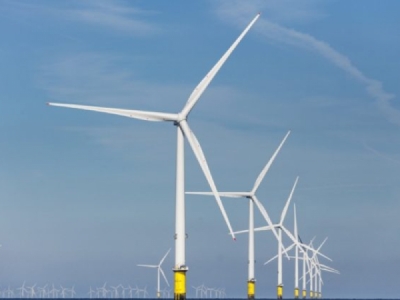
Posted on June 26, 2019
Offshore wind energy developer Ørsted was awarded a 1,100-megawatt commitment by New Jersey Friday for its Ocean Wind project off Atlantic City, the single largest award to date for the budding U.S. industry.
“After so many years New Jersey is finally open for business as far as offshore wind is concerned,” said Joseph Fiordaliso, president of the state Board of Public Utilities, after a unanimous vote to choose Ørsted to build the project on its federal continental shelf lease.

Ørsted contractors have been surveying the tract. It will be the first in what state energy planners hope will be three awards for offshore power, with a total capacity of 3,500 MW.
“We’re looking for competition. The competition only helps the ratepayer,” said Fiordaliso.
The Ocean Wind project would deliver a first-year price for Offshore Wind Renewable Energy Certificates (ORECs) of $98.10 per megawatt-hour. BPU officials estimate the levelized net OREC, representing actual costs paid by ratepayers after energy and capacity revenues are refunded to ratepayers, at $46.46/MWh.
That will increase average ratepayer monthly bills by $1.46 for residential, $13.05 for commercial, and $110.10 for industrial customers, according to the BPU.
Commissioners and BPU staffers said Ørsted edged out bids from Equinor and a partnership of EDF and Shell, based on criteria including projected power pricing, impact on ratepayers, environmental and economic impact, and prospects for success.
Ørsted looks poised to start and finish construction sooner too, said commissioner Robert Gordon. But “no developer has a lock on New Jersey” and both Equinor with its Boardwalk Wind proposal for a lease to the north, and the EDF/Shell plan for Atlantic Wind, should bid for the second and third rounds, he said.
Democratic Gov. Phil Murphy made offshore wind a priority when he took office in January 2018, and state officials are keenly interested in how developers plan to invest locally in their workforce, supplies and shore side support. Ørsted, which has a relationship with the state’s largest power company PSEG, scored high on that consideration too, BPU officials said.
Amid this political and regulatory momentum, Ørsted and state officials still must deal with intense concerns from other ocean industries, including maritime transportation and commercial and recreational fishing fleets.
Surf clam, scallop and trawl fishermen are insisting at a minimum that turbine arrays must be designed with safe transit lanes and sufficient space between the machines to continue mobile gear fisheries.
How to connect more than a dozen East Coast offshore wind projects is another major issue for the industry, and this week the federal Bureau of Ocean Energy Management announced it received a proposal to wire the New York Bight for Ørsted and other builders.
BOEM will consider the potential transmission line right of way requested by Anbaric Development Partners LLC to develop a “NY/NJ Ocean Grid,” and published a request for competitive interest to see if any other companies are interested.
ADP’s proposed transmission backbone could extend from Equinor’s Empire Wind array to be built off New York Harbor south to off Cape May, N.J. It would include several offshore collection points (OCPs), surface platforms capable of handling 800 MW to 1,200 MW of energy streaming from turbines and routing it to cables for landfall.
The initial BOEM review will also be an opportunity for the fishing industry and other stakeholders to comment on the proposed route.
“Comments may include information relating to potential effects on the environment and marine habitats; geological and geophysical conditions (including bottom and shallow hazards); archaeological, historic, and/or cultural resources; and the multiple uses that exist in the area, including commercial and recreational fishing,” according to the BOEM notice.
Source: coastalnewstoday.com





